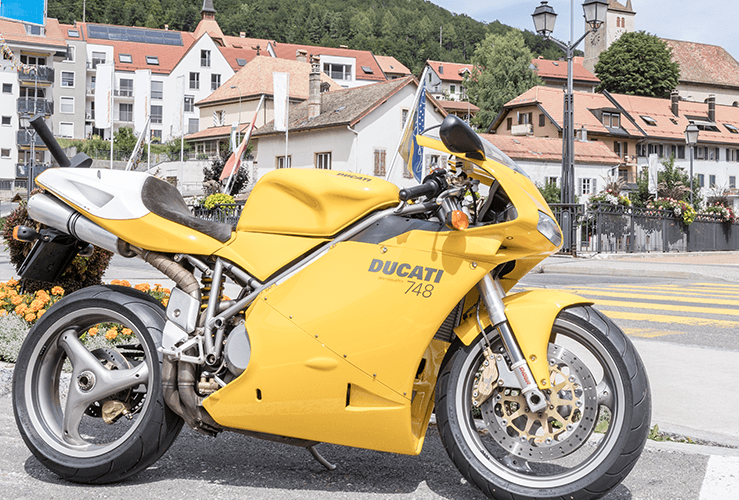If you're new to motorcycles, you may be wondering what the difference is between a single and a twin cylinder machine. If so, read on.
Single cylinder engines
Essentially, a single cylinder engine has, as the name suggests, one cylinder - and thus one piston. They are low-cost to manufacture but create a lot of vibrations making them a noisier option. Single cylinders deliver a lot of torque at the low-end, so they’re ideal for adrenaline-packed low-speed jaunts. However, at higher RPMs they are somewhat sluggish.
Twin cylinder engines
A twin cylinder engine has two cylinders and therefore two pistons. Because there are two of them, the pistons reduce each other’s vibration and improve balance (one goes up while the other goes down, and vice-versa). Twin cylinder motorbikes also boast higher revs, meaning more power. However, they may lack the torque of single cylinders.
Why are some engines multi-cylinder?
Multi-cylinder engines - including twins - are designed for a particular demographic that wants smoother power delivery and less noise. Multicylinders offer better performance and equipment for longer rides. Most riders wouldn’t want to attempt the Boscastle to Land's End run in a single cylinder, chiefly because of the discomfort and noise.

V-Twins
Among the twin engines available, the V-twin is perhaps the best-known and best-loved. Its V-shaped formation results in a smoother, more powerful motor and ride.
Twins are more complex and therefore more costly to produce. They are also more expensive to repair compared to single cylinder motorcycles.
Parallel twins
As the name suggests, this twin cylinder set-up has the pistons moving in parallel. With 360 degree twins, the cylinders can go up and down together, while 180 degree twins see the pistons move in opposite directions (one up, one down etc).
Parallels have issues with vibration, but can deliver a similar power profile to a V-twin - while costing less to manufacture.
Boxer twins
Boxer twins have each piston moving in and out (left and fight) at the same time, mirroring one another's movement. They each have their own crankshaft, unlike a regular V-twin. It is so-named because it resembles a boxer beating their chest.
Since the cylinders stick out, cooling is easier - but the extra width does affect ground clearance. Because of their bulbous shape, boxer engines are more liable to sustain damage off-road or filtering through traffic.
4 cylinder vs 2 cylinder motorcycles
Generally, the more cylinders on a bike, the more power it produces and the smoother it runs - so a four cylinder delivers more power than a two cylinder. Splitting the displacement into four small cylinders enables the engine to spin quicker, which means it can process more air and fuel, resulting in more power.
With that in mind, four cylinder engines are put to best use in sport bikes, while two cylinders are suited to all-round and off-road bikes.
Four cylinder bikes dominate MotoGP races thanks to their (generally) superior power.
That said, two cylinder engines can be placed lower down, which can improve handling, while four cylinders must be placed higher up, which is detrimental to handling.
3 cylinder vs 2 cylinder motorcycles
As you might have guessed, three cylinders have three pistons, which makes for a smoother, quieter ride, and more power. They offer better balance than a four cylinder, while offering the same level of reliability (assuming build quality and materials are equal).

Best single cylinder motorbike?
Many motorcycle brands remain committed to the single cylinder motorbike, resulting in a great deal of choice.
New singles on the scene include the Husqvarna 701 Svartpilen, boasting good handling, a powerful KTM engine, and supernatural design. Ideal for cruising B-roads while keeping up with your sports-bike-owning pals!
The CCM Spitfire is another one to consider if you desire paired-back biking. Harnessing a BMW-deigned and Husqvarna-built motor, it boasts 55 bhp and 43ft-lbs of torque. This funky British option has enjoyed huge success thanks in part to various celebrity endorsements.
True to its name, the Beta Alp is ideal for bike trails. Weighing in at just 133kg with a powerful 350cc engine, it's the mountain goat of off-roaders. Not as quick or good looking as the above two examples, but it offers a rugged tenacity that few others can match.
The Fantic Caballero 500 Scrambler is one of several scrambler bikes from Fantic that were inspired by their motocross machines. Some of these models took wins at the International Six Days Trial among other events.
These funky, retro-style bikes are available with 125, 250 and 500cc engines - all built by Zongshen.




